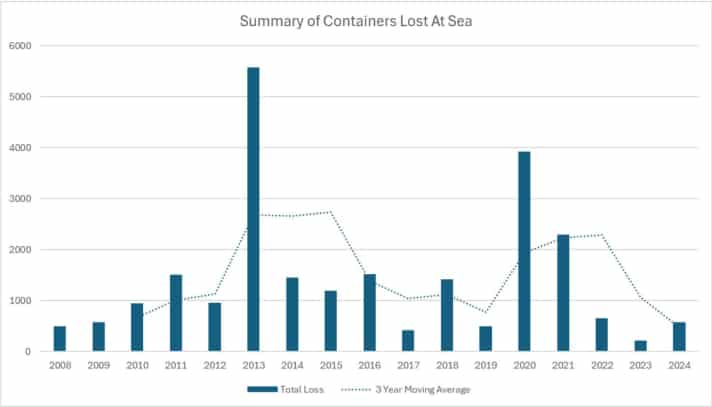Slight increase in 2024: Container losses - danger for water sports enthusiasts?






Container transport will see a slight increase in the number of containers overboard in 2024. According to the current report of the World Shipping Council (WSC), the largest shipowners' association, an estimated 576 containers were lost last year. This is an increase on the 221 containers lost in 2023, but the figure is still well below the ten-year average of 1,274 containers per year. With a total of around 250 million containers transported in 2024, the loss amounts to just 0.0002 per cent.
Despite the increase in 2024, the WSC emphasises that the long-term trend remains positive. Although the number of containers lost fluctuates considerably from year to year, it shows a clear improvement overall compared to previous years. The three-year moving average for 2022-2024 is 489 containers, which represents a significant decrease compared to the previous reporting period 2021-2023 with 1,061 containers.

However, individual accidents can drive these statistics up significantly. For example, a freighter lost 1,900 containers in the Pacific in 2020, while the "MOL Comfort" lost as many as 4,293 containers in 2013. The "MSC Zoe" lost 342 of its 8,062 containers in the southern North Sea in 2019.
Main reason for the increase
The WSC report cites the diversions of ships due to the ongoing tensions in the Red Sea as the main reason for the increase in container losses. This has led to a drastic increase in ship passages around the Cape of Good Hope. The South African Maritime Safety Authority reports that around 200 containers were lost in this region alone. This accounts for around 35 per cent of the total losses in 2024. The number of ship passages around the Cape increased by 191 per cent compared to the previous year.
New security initiatives
According to the report, the World Shipping Council continues to advocate for greater transparency and improved safety measures in the industry. From 1 January 2026, mandatory reporting of container losses to the International Maritime Organisation (IMO) will be introduced. This new regulation, which the WSC has long campaigned for, is intended to improve the data situation and lead to more targeted safety measures.
The industry is also working on various initiatives to improve container safety. The TopTier research project, in which the WSC is involved, will be completed this year and is intended to provide specific recommendations for preventing container losses. In addition, the WSC is working with the National Cargo Bureau to develop a new Cargo Safety Programme that will use artificial intelligence to improve the detection of incorrectly declared dangerous goods.
Shared responsibility
The WSC report emphasises that the safety of containers is a shared responsibility along the entire supply chain. From correct loading and declaration by shippers to safe stowage on the ship, all parties involved are required to play their part in ensuring safety. The report emphasises: "Every container that goes overboard is one too many, and shipping companies are working with other parties in the supply chain on a daily basis to improve safety."
A study by the insurance company HDI identifies further factors: the increasing size of container ships increases the surface area exposed to crosswinds. In addition, these ships are particularly susceptible to strong rolling motions due to their hull shape. Previous damage, the age of the containers, incorrect stowage and securing of the cargo and incorrect weight specifications can also lead to problems.
Dangers for skippers
The risk of colliding with one of these lost containers is almost impossible to quantify. Collisions with so-called UFOs - Unidentified Floating Objects - always cause a stir in the sailing world. At the Vendée Globe 2020, top favourite Jérémie Beyou had to turn back after a collision with flotsam. Sam Davies and Sébastien Simon also suffered collisions. In 2016/17, Alex Thomson, who was in the lead, was hit in the middle of the Atlantic, while Thomas Ruyant's yacht almost broke apart in the Pacific after a collision. Kito de Pavant even had to be rescued after a collision almost completely tore the keel off his yacht.
These dramatic incidents bring back memories of the opening scene of the film "All Is Lost", in which a half-sunken container rams the yacht of the single-handed sailor played by Robert Redford. But how realistic is this scenario really?
How many "UFOs" are there?
The steel structures, which weigh several tonnes, usually sink to the seabed. The speed depends on various factors, similar to a sinking ship. It is "extremely rare" for containers to float just above or below the surface of the water, says Holger Flindt from the insurance broker Pantaenius.
There is also a large statistical uncertainty. This is because many sailors who collide with something do not know exactly what the object of the collision was. Collisions with other flotsam such as nets, tree trunks, rafts or Euro pallets - and not least marine mammals - are more likely than a container collision.

